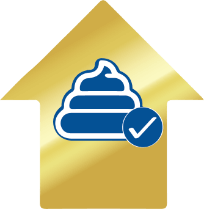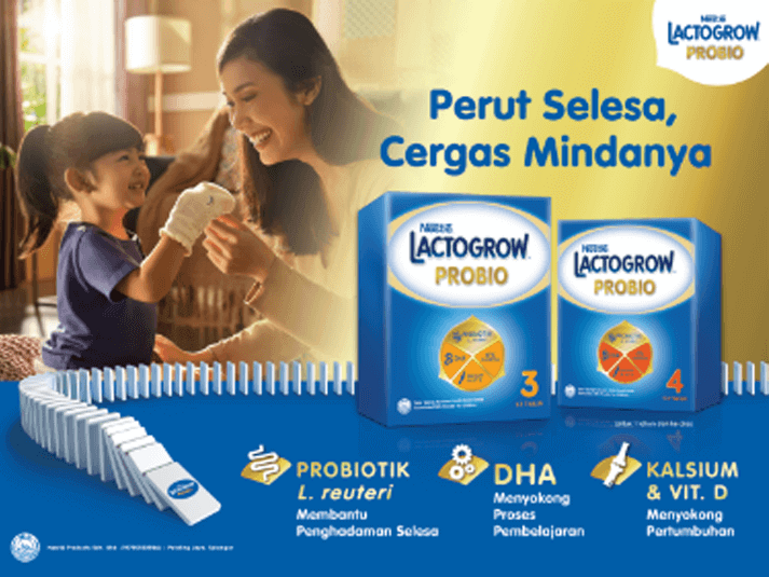Formula Milk LACTOGROW PROBIO
The only formula milk for children with probiotic L. reuteri*
Mom, did you know? when your child's tummy is well, he or she can focus better. Probiotic and DHA support the development of their minds for good growth.
L. reuteri: The best studied probiotic & shown to be compatible for children1,2
Research shows that formula milk powder for Children with L. reuteri is effective in minimising gut discomfort such as constipation, stomachache and vomiting.

Less Crying

Less Spitting Up

Less Fussy

Better Stooling Pattern

Less Bloating
L. reuteri helps to improve the child’s digestive system resulting in a comfortable stomach and promotes nutrients absorption. Did you also know? Probiotic cultures may help to reduce the incidence of consitipation.3
Key Product Benefits
PROBIOTIC L. reuteri
Helps improve gut and digestive function.
DHA
Found abundantly in brain and eyes to support learning progress.
Calcium & Vitamin D
Calcium supports strong bone and teeth development. Vitamin D helps with calcium absorption.
0% Sucrose
Good choice for your little one.
Shop LACTOGROW PROBIO at Our Official Stores
Most popular products
Other recommended products

Jaundice: Causes, signs and treatment
Jaundice is the health condition that turns a child’s skin and sclera into yellow, due to high bilirubin levels in the blood.
3 mins to read

Understanding and Managing Kid’s Indigestion
We'll explore everything Malaysian parents need to know about kids' indigestion, including its causes, symptoms, treatment options, and practical tips for prevention
4 mins to read

Solving your Child's Constipation
Constipation is a common health hiccup in kids that may cause a bit of a scare for parents
4 mins to read

Are Probiotics Safe for Kids? Let’s Dig into the Facts
We'll explore what probiotics are, their benefits, and if they're safe for children.
3 mins to read

Understanding & Soothing Intense Crying amongst Children
Welcoming a child into the world brings immense joy and love, but it also comes with challenges, one of which is soothing crying children
4 mins to read

Why Probiotic Limosilactobacillus reuteri is a Game Changer for Child Health
Probiotic Limosilactobacillus reuteri (Lactobacillus reuteri) can be a game changer when it comes to the importance in child health
5 mins to read

Unpacking the Perks of Probiotic Milk for Kiddos
When it comes to understanding probiotics and benefits, it's simple. Picture a tiny army of good bacteria, ready to boost your kid's health.
5 mins to read

Probiotics, Prebiotics and Antibiotics
Did you know what’s the difference between Probiotics, Prebiotics and Antibiotics?
2 mins to read

3 Simple Steps to Improve Your Child’s Immunity
The immune system is your child’s first line of defence against disease-causing microorganisms
2 mins to read

Child’s Immunity Boosting Foods
Let Your Child Try These Immunity Boosting Foods The immune system
2 mins to read
EXPERTS ANSWER tO ALL YOUR QUESTIONS
Why is Probiotic important for your Little One?
For a healthy gut, your Little One needs 85% good bacteria. Probiotic is good bacteria that helps digestive function for a comfortable tummy and better nutrient absorption for a brighter mind.
At what age can I introduce my child to LACTOGROW PROBIO?
LACTOGROW PROBIO 3 is recommended for children between 1 to 3 years old.
LACTOGROW PROBIO 4 is recommended for children between 4 to 6 years old.
We recommend that you speak to your healthcare professional about how to feed your child and seek advice on when to introduce this product.
Can LACTOGROW PROBIO help with constipation among children?
LACTOGROW PROBIO contains Probiotic L. reuteri to support your child’s digestive function for a comfortable tummy. This may help to reduce constipation and other gut discomforts.
We recommend that you speak to your healthcare professional about how to feed your child and seek advice on when to introduce this product.
What is the difference between LACTOGROW PROBIO and LACTOGROW?
Effective November 2023, LACTOGROW is rebranded to LACTOGROW PROBIO. The formerly known LACTOGROW 3 and LACTOGROW 4 are replaced with LACTOGROW PROBIO 3 and LACTOGROW PROBIO 4 respectively. Rest assured that there are no changes in the formulation; both the new LACTOGROW PROBIO 3 & LACTOGROW PROBIO 4 packaging versions continue to offer the same benefits as the current packaging, as they contain the same formulation.
What is the difference between LACTOGROW PROBIO and LACTOGROW Aktif?
LACTOGROW PROBIO (previously known as LACTOGROW) contains Probiotic L. reuteri and DHA. Probiotic L. reuteri can help promote good digestive function for your Little One’s comfortable tummy, while DHA supports learning potential for a brighter mind.
LACTOGROW Aktif contains AktifGro + DHA. It is a combination of 18 vitamins & minerals including key growth nutrients such as High Calcium, Protein, Iron and Zinc to support Your Little One’s active development.
Where can I find LACTOGEN 3 & LACTOGEN 4 in Malaysia?
LACTOGEN 3 & LACTOGEN 4 is not available in Malaysia. However, what we have available is LACTOGROW PROBIO 3 and LACTOGROW PROBIO 4 formulated milk powder for children.
What are the ingredients in LACTOGROW PROBIO Milk?
Ingredients: Skimmed Milk Powder (Cow's Milk), Lactose (Cow's Milk), Sunflower Oil, Coconut Oil, Low Erucic Rapeseed Oil, Minerals (Calcium Citrate, Sodium Phosphate, Potassium Citrate, Magnesium Citrate, Ferrous Sulphate, Sodium Citrate, Zinc Sulphate, Copper Sulphate, Potassium Chloride, Manganese Sulphate, Sodium Selenate), Emulsifier (Soya Lecithin), Vitamins (C, E, Niacin, B5, B1, A, B6, B2, Folic Acid, K1, Biotin, D3, B12), Flavouring, Docosahexaenoic Acid (Fish Oil), Probiotic Cultures (Lactobacillus reuteri DSM 17938)*. Contains Permitted Emulsifier and Flavourings. Food Additives Are Of Plant Or Synthetic Origin.
*Under license from BioGaia AB
What is the nutritional info of LACTOGROW PROBIO Milk?
| Serving Size / Saiz Hidangan : 32g | Serving Per Pack / Jumlah Hidangan : 37 | ||
| Average Composition / Purata Komposisi | Per / | Per Serving / | |
| Tenaga / Energy | kcal | 486 | 156 |
| Lemak / Fat | g | 21.4 | 6.8 |
| Asid Lemak Monotidaktepu / Monounsaturated Fatty Acid | g | 10.7 | 3.4 |
| Asid Lemak Politidaktepu / Polyunsaturated Fatty Acid | g | 4.0 | 1.3 |
| -Asid Dokosaheksenoik / Docosahexaenoic Acid (DHA) | mg | 30 | 10 |
| -Asid Linoleik / Linoleic Acid | g | 3.5 | 1.1 |
| -Asid a-Linolenik / a-Linolenic Acid | mg | 300 | 96 |
| Asid Lemak Tepu / Saturated Fatty Acids | g | 5.2 | 1.7 |
| Asid Lemak Trans / Trans Fatty Acids | g | 0.2 | 0.0 |
| Protein | g | 14.6 | 4.7 |
| Karbohidrat / Carbohydrate | g | 58.8 | 18.8 |
| Jumlah Gula / Total Sugars | g | 54.0 | 17.3 |
| Laktosa / Lactose | g | 54.0 | 17.3 |
| Sukrosa / Sucrose | g | 0.0 | 0.0 |
| Natrium/Sodium | mg | 344 | 110 |
| Kalium / Potassium | mg | 750 | 240 |
| Klorida / Chloride | mg | 456 | 146 |
| Kalsium / Calcium | mg | 871 | 279 |
| Fosforus / Phosphorus | mg | 448 | 143 |
| Magnesium | mg | 66 | 21 |
| Selenium | μg | 33 | 11 |
| Vitamin A | μg RE | 456 | 146 |
| Vitamin D | μg | 6.1 | 2.0 |
| Vitamin E | mg TE | 9.2 | 2.9 |
| Vitamin K | μg | 25 | 8.0 |
| Vitamin C | mg | 97.0 | 31.0 |
| Vitamin B1 | mg | 0.6 | 0.2 |
| Vitamin B2 | mg | 0.9 | 0.3 |
| Niasin / Niacin | mg | 4.5 | 1.4 |
| Vitamin B6 | mg | 0.6 | 0.2 |
| Asid Folik / Folic Acid | μg | 120 | 38 |
| Asid Pantotenik / Pantothenic Acid (B5) | mg | 3.9 | 1.2 |
| Vitamin B12 | μg | 1.0 | 0.3 |
| Biotin | μg | 16.0 | 5.1 |
| Zat Besi / Iron | mg | 6.1 | 2.0 |
| lodin / lodine | μg | 100 | 32 |
| Zink / Zinc | mg | 4.3 | 1.4 |
MENGANDUNGI 106 cfu/g KULTUR PROBIOTIK/CONTAINS 106 cfu/g PROBIOTIC CULTURES Jumlah Gula adalah daripada Laktosa Susu / Total Sugars Contributed by Milk Lactose Saiz Pencedok = 4.6g / Scoop Size = 4.6g | |||
*Comparison between major brands of formula milk powder for children in the same price range (< RM35/kg) in Sep 2023 (Nielsen Mass Growing Up Milk Segment Step 3,4)
- LACTOGROW 3 & LACTOGROW 4 is also known has LACTOGROW PROBIO 3 & LACTOGROW PROBIO 4
References:
1. Srinivasan R et al. Pediatr Ther 2018; 8:3.
2. Happy Tummy Consortium. Nutrients. 2023; 15(3) 530.
3. Jung C et al. Int J Child Health Nutr 2017; 6:62–69.





